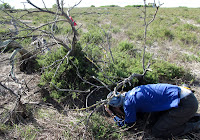 Richard, Kelley and I were dropped on the road just past the harbour, and
following a route called NPR-N we checked the nests for eggs and chicks. As these are checked at regular intervals
every 5-6 days, you know from the last visit what should be there. In most of the nests, we found what was
expected. The eggs and chicks all coded and the visit recorded. Eggs were coded E0 if new (very clean and
white), EU for an egg of unknown age (it’s hard to tell the age if older than a
day or so up to hatching), and EA for egg abandoned if there was no adult
there. The chicks were coded P (for
precocious?). P0 is new-born to 2 days old, with eyes still shut. P1 is small,
young and fluffy. P2 is larger, with the parent still able to cover the chick
under their wing. P3 is becoming larger and starting to lose down around the
face. By P4 the chick is nearly fully fledged, with blue/grey more waterproof
feathers.
Richard, Kelley and I were dropped on the road just past the harbour, and
following a route called NPR-N we checked the nests for eggs and chicks. As these are checked at regular intervals
every 5-6 days, you know from the last visit what should be there. In most of the nests, we found what was
expected. The eggs and chicks all coded and the visit recorded. Eggs were coded E0 if new (very clean and
white), EU for an egg of unknown age (it’s hard to tell the age if older than a
day or so up to hatching), and EA for egg abandoned if there was no adult
there. The chicks were coded P (for
precocious?). P0 is new-born to 2 days old, with eyes still shut. P1 is small,
young and fluffy. P2 is larger, with the parent still able to cover the chick
under their wing. P3 is becoming larger and starting to lose down around the
face. By P4 the chick is nearly fully fledged, with blue/grey more waterproof
feathers.We also tried to ID the adult penguin(s) that were on the nest. There was normally just one parent present, whilst the other was off fishing. We had a book of photographs to compare to. They have distinctive spot patterns on their belly. When they are on the nest and the belly can’t be seen, there are often identifying features on the face and neck.
 On the way, we had to drive through a colony of swift terns
nesting literally in the village. It was like a scene out of Hitchcock’s ‘The
Birds’. There were several dead birds in the road, and we had to dodge several
others. There are two visiting
post-grads studying the relationship between weight and size of head, to gauge
parameters for healthy birds. As we returned back to the house for lunch, we
stopped and watched for a while as they collected the chicks up, weighted them
in bags, and measured their head using digital callipers. They were then
released and scampered off back to the colony. – the birds, not the post-grads.
On the way, we had to drive through a colony of swift terns
nesting literally in the village. It was like a scene out of Hitchcock’s ‘The
Birds’. There were several dead birds in the road, and we had to dodge several
others. There are two visiting
post-grads studying the relationship between weight and size of head, to gauge
parameters for healthy birds. As we returned back to the house for lunch, we
stopped and watched for a while as they collected the chicks up, weighted them
in bags, and measured their head using digital callipers. They were then
released and scampered off back to the colony. – the birds, not the post-grads.We walked back to the house for lunch, and had an hour to chill out afterwards before our next task.
In the afternoon we did a molting check along the coast. As
opposed to checking nests, we were checking out the groups of penguins hanging
out along the coast. These were normally juveniles and adults who had returned
from swimming from mid-afternoon onwards.
We saw lots of other birds including: guinea hen (blue head
and a little crest), spur hen (more grey), peacock, swift tern, kelp gul,
kestrel, black oystercatcher and an African sacred ibis … as well as lots of
penguins!
No comments:
Post a Comment